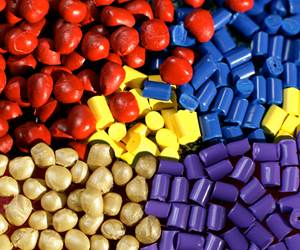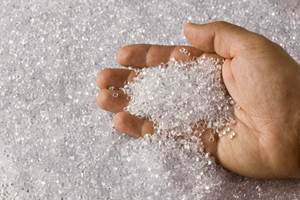June 2025: Prices for the Five Commodity Resins Flat to Down
This overall resin pricing trend could continue into the start of the third quarter.

Slowed domestic and export demand, lower feedstock costs, continuing uncertainty of tariffs and their impact on supply-demand fundamentals, and concerns about the overall economy’s direction are among the contributing factors for the flat-to-down trajectory of prices for polyethylene (PE) polypropylene (PP), polystyrene (PS), polyvinyl chloride (PVC) and polyethylene terephthalate (PET). Supply outpacing demand continues to be a factor, which has led to resin suppliers curtailing production rates even further. The start of the hurricane season this month coupled with lower prices might result in a spike in demand due to potential prebuying, though most processors have continued to only buy as needed.
These are the views of purchasing consultants from Resin Technology Inc. (RTi); David Barry, associate director for PE, PP and PS at PetroChemWire (PCW) by OPIS; Michael Greenberg, CEO of Resintel, the market intelligence service of The Plastics Exchange; Scott Newell, executive VP polyolefins at distributor/compounder Spartan Polymers; and Mike Burns of Plastic Resin Market Advisors.
Noting that buyers’ sentiment for polyolefins remained negative with continued reserve due to the extended tariff situation, Resintel’s Greenberg says, “Despite the ongoing political posturing, the 90-day reprieve (announced on April 8) on excessive tariffs remains in place for a majority of foreign trading partners, and it has helped shore up better export resin demand. The dollar continued to weaken, aiding the competitiveness of resin exports, though international prices continued to slide as producers and traders alike vied for coveted orders.”
The latest update on PE tariffs to China from Plastic Resin Market Advisors’ Burns referred to several unconfirmed reports that China would be eliminating the 125% tariff on PE imports. “Such a policy change would enable U.S. suppliers to resume exports to China in an effort to regain some control on mounting inventories rising from the recent export challenges.” For the first two months of 2025, China’s total PE imports from the U.S. equaled 1 billion pounds — about 20% of the total China PE imports. In 2024, total imports from the U.S. were just over 17%, while in 2023, the U.S. had surpassed the Middle East to become the largest source of PE imports for China.
PE Prices Down
PE prices in April dropped by 5¢/lb as both domestic spot and export prices fell 7-8¢/lb, despite suppliers’ attempt at a 5¢/lb April increase. Projections for the May-June time frame ranged from flat to possibly further down, according to PCW’s David Barry, Resintel’s Michael Greenberg, Mike Burns of Plastic Resin Market Advisors, and Kevin Mekaru, RTi’s senior ┤¾¤¾┤½├¢ leader commodity plastics. Still, at least one supplier at press time, LyondellBasell, had issued a price increase of 5¢/lb, effective May 1.
Barry reported there were growing signs of strain in the market as suppliers had excess production and no access to the China market because of the trade war. He noted that HDPE injection molding and blow molding resins were the longest in supply due to new capacity. RTi’s Mekaru noted that due to a drop in exports, PE plant operating rates were being dropped to the mid-80s percentagewise in April and May compared to March’s 92%. These sources also expected LLDPE and LDPE supply to increase with the conclusion of planned maintenance outages. Says Plastic Resin Advisors’ Burns, “Suppliers’ reliance on the export market to manage the record production rates is exceptionally challenging. Inventories will continue to outpace total sales in Q2. Steady U.S. demand and export tariff challenges are favoring the domestic market. Resin availability and prices should remain favorable for the U.S. processor. Processors should manage inventories as needed.”
Resintel’s Greenberg reported that U.S. resin buyers remained in a defensive mode, generally only procuring as needed and working down on-hand resin supplies and finished goods inventories, noting that this has been an ongoing trend. “The best spot export demand has come from Europe, which faces high local feedstock costs, plant shutdowns and challenging logistics from Asia and most Middle East suppliers. Latin America interest is there, but it’s inundated with well-priced Asian offers, some from rerouted Chinese shipments. Though higher volume export sales have again been developing, they are not yet considered robust, and growing upstream PE supplies are bleeding into the domestic market.”
PP Prices Drop Further

PP prices in April dropped 6¢/lb in concert with propylene monomer contracts, which settled at 38¢/lb. With spot monomer prices dropping by as much as 8¢/lb in April vs. May, some further price erosion in May was possible, with the month likely to see flat pricing, according to PCW’s Barry, Spartan Polymers’ Scott Newell, Resintel’s Michael Greenbert and Paul Pavlov, RTi’s VP of PP and PVC.
RTI’s Pavlov noted that demand was down year to date from 2024 and ventured that PP prices would drop about 5¢/lb in April and possibly a bit more in May. Expecting further price relief in April, after March’s 4¢/lb drop, Resintel’s Greenberg noted that after six to seven months of below average buying, processors had a good opportunity to rebuild stocks at some of the lowest PP prices in the past few years.
PCW’s Barry noted plant operating rates were estimated to be in the low 70s percentagewise at best, with PP supply characterized as adequate. There were some deals for PP exports to Latin America and Barry noted that such exports need to be priced in the mid-to-high 30¢/lb range. He heard of one deal made at 34¢/lb. Regarding PP export prices Spartan Polymers’ Newell says, “If suppliers are cutting deals that low, there’s little profit, and it means the market is not in good shape.” He noted that supplier inventories increased while demand was down, bringing days of supply to 40, vs. mid-to-high 30s.
PS Prices Drop, Then Flat
PS prices in April dropped by 3¢/lb, reversing the March increase, according to PCW’s Barry and RTi’s Pavlov. Both sources ventured that flat pricing would prevail within May and June, as supply has been steady while demand continues to be slow, along with lower costs of feedstocks, particularly benzene. The implied styrene price, based on a spot formula of 30% ethylene and 70% benzene, was down 4.7¢/lb through much of April. PS supply was regarded as adequate, with relatively decent spot resin availability.
PVC Prices Largely Flat

PVC prices in April rolled over following the total of 3¢/lb increases in the February-March time frame. Moreover, the flat pricing trend was expected through May and June, according to RTi’s Pavlov. He noted that demand was higher in the first quarter than in the 2024 year-to-date time frame and would likely be higher within the second quarter largely due to exports, primarily to Latin America, as well as domestic demand from the pipe sector. He noted that plant operating rates have continued to be around 70%, owing to sluggish demand in the major construction sector, lower feedstock costs and a 10% increase in new capacity.
PET Prices Up a Bit, Then Flat

PET prices in April moved up by 1-2¢/lb versus the 5¢/lb increase originally expected, according to RTi’s Mekaru, and that was because PET resin was exempted from tariffs, though the 25% tariffs on aluminum remained at press time. He ventured that prices in May and June were likely to roll over due to slower demand than 2024 year-to-date, economic uncertainty and uncertainty of tariffs on key feedstocks, including paraxylene and PTA, which have not been exempted. Still, feedstock costs year-to-date have been about 9% lower than 2024. Mekaru noted that the well-priced PET imports will continue to be a factor in the market and, depending on the status of the aluminum tariffs going forward, PET demand could be on the increase.
Related Content
Fundamentals of Polyethylene – Part 6: PE Performance
Don’t assume you know everything there is to know about PE because it’s been around so long. Here is yet another example of how the performance of PE is influenced by molecular weight and density.
Read MorePrices Up for PE, PP, PS, Flat for PVC, PET
Trajectory is generally flat-to-down for all commodity resins.
Read MorePolyethylene Fundamentals – Part 4: Failed HDPE Case Study
Injection molders of small fuel tanks learned the hard way that a very small difference in density — 0.6% — could make a large difference in PE stress-crack resistance.
Read MoreDelivering Increased Benefits to Greenhouse Films
Baystar's Borstar technology is helping customers deliver better, more reliable production methods to greenhouse agriculture.
Read MoreRead Next
March 2025 Resin Pricing: Commodity Resin Prices Firm Up
Unplanned and planned production disruptions, rising feedstock costs and variables such as the potential impact of pending tariffs all factor in.
Read MoreApril 2025: Mixed Bag for Prices of Volume Resins
The end of the first quarter marked higher prices for polyolefins and relatively flat pricing for nearly all other resins.
Read MoreMay 2025: Prices for 4 of the 5 Commodity Resins Flat-to-Down
PET is the exception from this general trajectory, at least for now.
Read More













